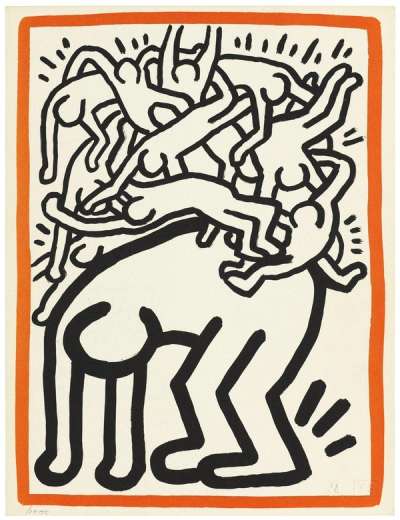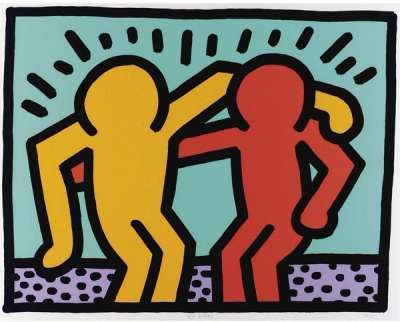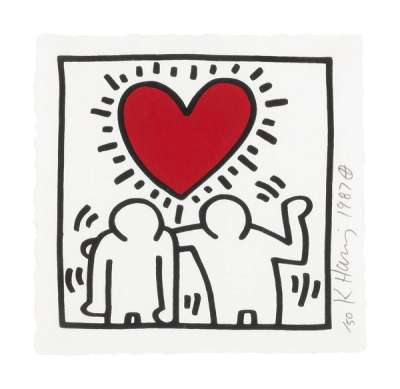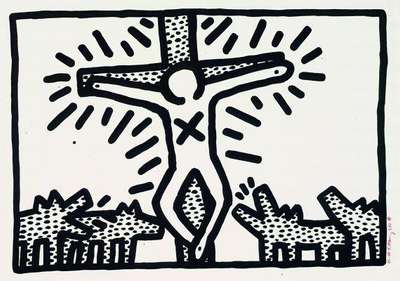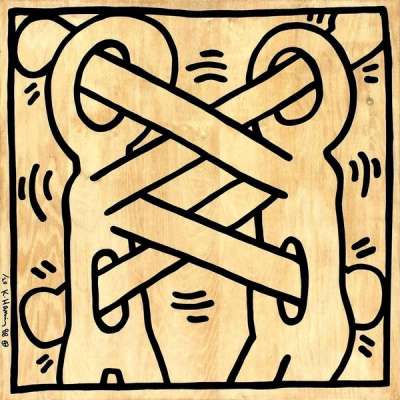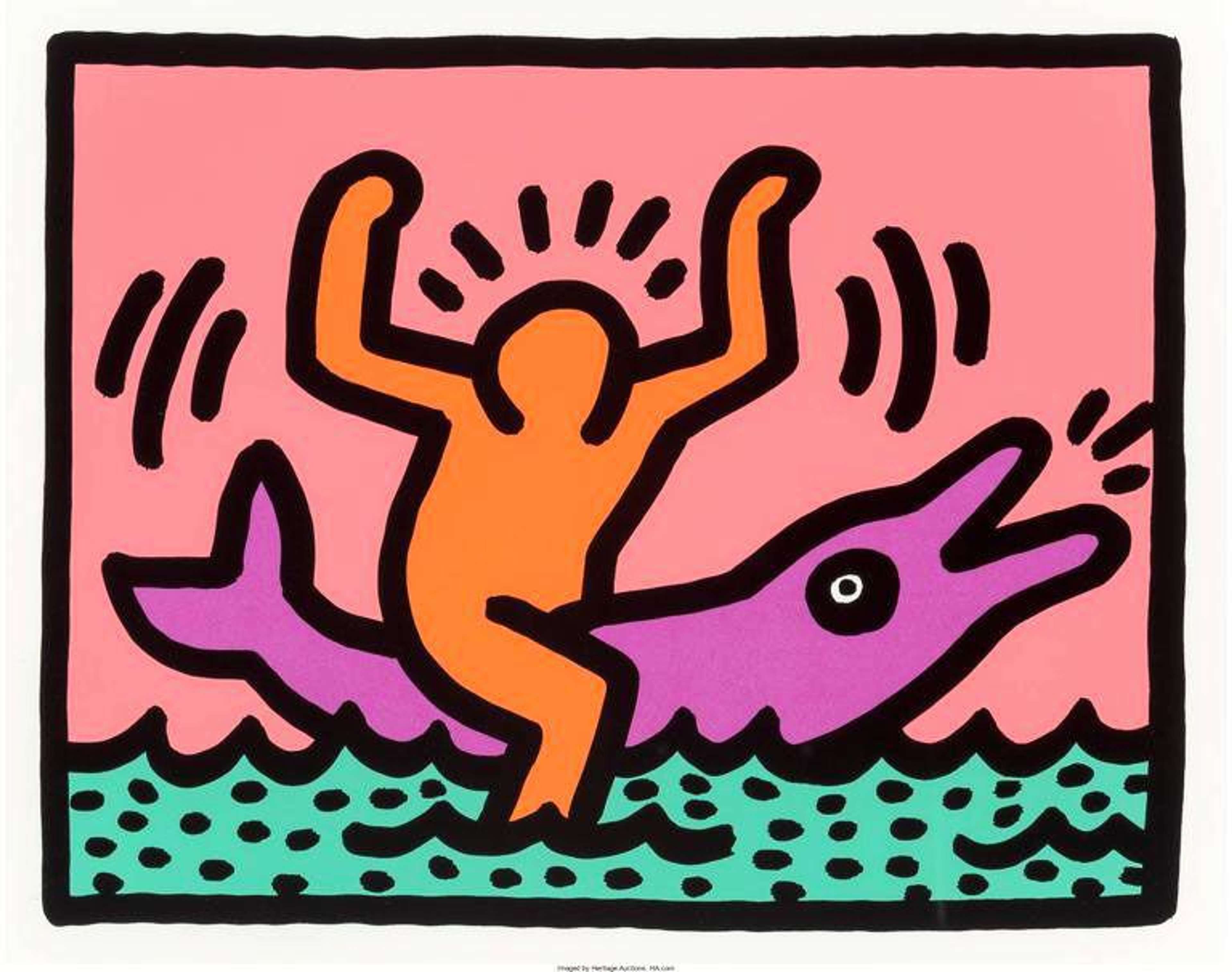Keith Haring’s AIDS Activism

 Image © Creative Commons via Flickr / Reproduction of Keith Haring's AIDS mural in Barcelona 1989.
Image © Creative Commons via Flickr / Reproduction of Keith Haring's AIDS mural in Barcelona 1989.
Keith Haring
250 works
It is hard to overstate the devastating impact that the AIDS epidemic had in the psyche of the 1980s. Fear, confusion and misinformation ran rampant as people tried to make sense of this new disease that seemed to suddenly and permanently afflict some of the brightest minds of the social and cultural milieu. Nowhere was that more true than in New York City, where artists seemed to be dying in large numbers. Enter Keith Haring, who by the late 80s was already world renowned for his distinct artistic style and socially conscious activism that spanned from anti-racism to anti-drugs. As the AIDS epidemic hit close to home, affecting friends and ultimately Haring himself, he felt an unwavering commitment to shed light on this looming crisis.
In a society often riddled with denial and prejudice, Haring chose to utilise his growing platform to confront the epidemic head-on. He orchestrated art-based campaigns, participated in activist groups, and created poignant pieces that were both a cry for help and a message of hope. Collaborating with organisations and fellow artists, Haring became a beacon for AIDS awareness, proving that art could be at once aesthetically captivating and socially impactful.
1980s New York City: The Perfect Backdrop for Haring
The 1980s were a tumultuous time in New York City's history. Amidst the backdrop of soaring skyscrapers, buzzing underground clubs and the city's relentless energy, there was a dark underbelly filled with drugs, unsafe sex and violence. Regardless, the art scene was thriving with the likes of Andy Warhol and Jean-Michel Basquiat, and the decade was marked by socio-political shifts and burgeoning subcultures from punk to hip-hop. It was in this cultural milieu that Haring first emerged, using the city as an expansive canvas and creating chalk drawings on black advertising panels in subway stations. His dynamic visuals – populated with radiant babies, barking dogs and dancing figures – immediately captured the zeitgeist of the time. He directly engaged with a diverse urban audience, as the raw nature of the city's streets provided inspiration and allowed his art to be experienced by people from all walks of life. It was this accessibility that caused him to stand out, creating a dynamic with the public that meant that Haring could wield his art as a powerful instrument of change.
Haring's Sexuality in His Art
Haring's artistry is indelibly intertwined with his sexuality, serving as a bold celebration of queer love and a poignant commentary on the LGBTQ+ experience during the tumultuous 1980s. Openly gay and working amidst the shadow of the AIDS epidemic and widespread stigmatisation, Haring's vibrant depictions of same-sex relationships and gay intimacy stood as defiant counter-narratives. His pieces were not merely depictions of queer desire; they actively confronted the era's entrenched homophobia, highlighting the discrimination and violence faced by the LGBTQ+ community. The fluidity and dynamism in Haring's work, replete with bold portrayals of the human body, echoed the ethos of sexual liberation movements, challenging prevalent taboos surrounding queer sexuality.
Haring had participated in safe sex campaigns since at least 1985, which unfortunately did not keep him from being diagnosed with HIV in 1988. His personal experiences with the disease, combined with the broader traumas of the LGBTQ+ community, became integral themes in his work. Through evocative symbols and narratives, Haring communicated the anxieties, sorrows and resilience of those affected, making the personal profoundly political. This intertwining of his life's realities with his creative expressions rendered his work all the more poignant.
Haring's Activism Pre-Diagnosis
By the mid-1980s, Haring was already world-famous for his activism in a variety of causes. From the outset, his decision to create art in public spaces was itself a form of activism, as he believed in making art accessible to all, irrespective of socio-economic status. This democratisation of art challenged traditional art world elitism and barriers, and remained a key tenet of his artistic practice until his death.
Apart from his aforementioned LGBTQ+ works, his activism took on both domestic and international issues. One of the most famous instances of this was his stand against apartheid in South Africa, as he created artwork that expressed solidarity with the oppressed Black South Africans and openly condemned the brutal racist regime. Haring also loved working with children, frequently depicting them in his art and expressing concern for their wellbeing. He strongly believed in fostering creativity in young people, often participating in numerous public projects and workshops with children, advocating for their rights and emphasising the importance of youth in society.
Furthermore, as the Cold War and the looming threat of nuclear bombs significantly influenced the global psyche in the early 1980s, Haring addressed these anxieties in his work. By often incorporating symbols of atomic explosions and mutated beings, he reflected the widespread fear of nuclear devastation and actively encouraged an anti-war stance. He also tackled the crack epidemic in 1980s New York, creating the famous Crack Is Wack mural.
Outlook After Diagnosis and Death
Haring was diagnosed with HIV in 1987 and AIDS in the autumn of 1988, after having difficulty breathing and noticing a purple lesion on his leg. By this point, he had already lost dozens of friends to the disease, and had himself expressed surprise at not having been afflicted up to that point. The diagnosis acted as motivation for Haring, as he became more immersed than ever in his work and frantically created pieces all over the world. He painted in hospitals, orphanages, day cares and other charities, while also creating campaigns to boost awareness of AIDS.
Almost immediately, he was open about his diagnosis in interviews, stating that "when AIDS became a reality in terms of my life, it started becoming a subject in my paintings. The more it affected my life the more it affected my work." His August 1989 interview with Rolling Stone is a vulnerable and open conversation about the disease and the artist's mortality, and reflects how much Haring was passionate about raising awareness about AIDS. The interview remains a huge testament to Haring's emotional maturity and intellect. He became a major supporter for ACT UP, the AIDS Coalition to Unleash Power, often creating artworks for them and donating thousands of dollars to their initiatives.
Haring died on February 16th 1990, at the age of 31. He passed away at his home in Manhattan, less than two years after his diagnosis. Few details are known about his final days, but Haring is known to have worked until the very end. A workaholic through and through, he had previously expressed fears about leaving his oeuvre unfinished, but acknowledged that "if I could clone myself, there would still be too much work to do – even if there were five of me."
Haring had made peace with the idea of death, stating "it’s not a limitation, in a way. It could have happened any time, and it is going to happen sometime. If you live your life according to that, death is irrelevant. Everything I’m doing right now is exactly what I want to do."
Most Famous Works and Campaigns
Haring's first campaign approaching the theme of Safe Sex was done in 1985. Shortly following his diagnosis, his art takes a darker turn as Haring begins to explore imagery showing spermatozoa with devil’s horns, indicating the pain and suffering that comes with HIV. This darker imagery continued in Apocalypse and The Valley, two series by Haring with text from William S. Burroughs dating from 1988 and 1989, respectively. Apocalypse takes a collage-like approach, while The Valley is done in a more realistic style than most of Haring’s cartoonish figures. Both line drawings show scenes of horror and chaos at the end of times.
In February 1989, he created a mural in Barcelona that raised awareness of the virus, and openly claimed that "Together we can stop AIDS". The work contains many of his trademark motifs, including the dancing figures, snakes, hypodermic syringes (which were frequently found at the location of the mural) and the three figures of see no evil, speak no evil and hear no evil. Although it was meant to be ephemeral, it has been recreated by the city several times. That same year he created the painting and print Silence Equals Death, which was produced to raise funds for the Outreach Fund for AIDS. In this work, Haring openly references the Silence = Death campaign poster, which subverts the imagery of the pink triangular badge worn in Nazi concentration camps to identify homosexual men. Acting as a background to Haring’s numerous faceless and genderless intertwined figures, which represent the thousands of victims of AIDS.
In his capacity as a supporter for the charity ACT UP, Haring created various posters and invites to raise awareness and money to the cause. One of the most famous ones is Ignorance = Fear / Silence = Death, which is a simplified approach to the painting he had created earlier that same year, utilising the motif of see no evil, speak no evil and hear no evil.
One of his last works marks a return to the dark imagery of The Valley. The Blueprint Drawings from 1990 illustrate the "otherness" and isolation felt by many in the LGBTQ+ community and others afflicted by AIDS. Although the themes of death and isolation meant the drawings failed to sell originally, its print run was successful and marks Haring's last cohesive project before his death.
Keith Haring and AIDS Activism: An Enduring Legacy
Haring was more than an artist; he was a passionate activist, leveraging his prominence to champion queer rights, AIDS awareness and social acceptance for disadvantaged communities around the world. His art, vibrant and emotive, became a powerful vehicle for drawing attention to the pressing issues of his time and advocating for love, unity and acceptance. Haring was also fiercely unapologetic about his sexuality, a trait that has empowered generations of artists to more confidently and positively express their sexuality in their work.
Haring established the Keith Haring Foundation in 1989, which to this day "perpetuates Haring's artistic and philanthropic legacy through the preservation and circulation of his artwork and archives, and by providing grants to children in need and those affected by HIV/AIDS." Haring's profound commitment to AIDS activism stands as an emblematic testament to the potential of art to catalyse positive transformation. As both a beacon within the LGBTQ+ community and the art world, Haring confronted the AIDS epidemic with unparalleled candour and compassion. Melding personal experience with broader advocacy, he harnessed his distinctive artistic language to challenge stigmas, educate the public and rally for change. His legacy serves as a powerful reminder of the enduring impact art can have in addressing pressing societal challenges, inspiring successive generations to champion understanding, hope and empathy in the face of adversity.











